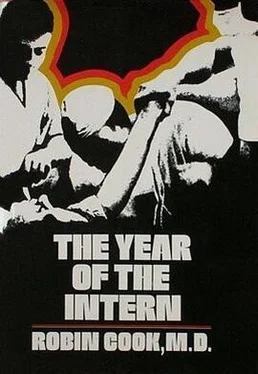So the early hours of Saturday passed, a combination of glorified pediatric clinic, suturing factory, and occasional true crisis. The few suturing jobs had been routine and rapid. My only disturbing problem had been that bearded fellow, but the hours and the tedium dulled it sufficiently so that the day became a typical one of generalized monotony punctuated by infrequent but memorable moments of terror and uncertainty.
I was actually beginning to like the quick, uninvolved routine of the ER. No patient required such deep attention as to make a real claim on my emotions. I could remember when it had been different, six months ago, back at the beginning of my internship. Mrs. Takura, for instance, had gotten to me. We had become friends; her long operation, throughout which I held the retractors, unable even to see her wound, had been a physical and emotional trauma. When I finally got away from her operation, out to the beach with Jan, I had been secure in my intuition that Mrs. Takura would pull through. Returning to find her dead had been the final, backbreaking straw in my disenchantment with what was happening to me as an intern. I had blown up at the system — at petty day-to-day harassment, the retractors, the lack of teaching, and the constant, nagging fear of failure. It had taken me a long time to get over Mrs. Takura, and, finally, I hadn’t so much accepted her fate as merely put it aside, vowing not to get emotionally involved again. It became easier, then, not to let patients get inside me. I began to think of them in hard, clinical terms, as so many hemorrhoids, appendixes, or gastric ulcers.
Roso had also been a trial. Unlike the short time with Mrs. Takura, my rapport with him had developed over several months. I even gave him a haircut, after he had been with us so long that his hair was a shabby mane flowing halfway down his back. He didn’t have any money, so I offered to cut it if he wanted me to. He was delighted; perched high on a stool in the sunlight of the alcove by the ward, he seemed proud to be alive. Everybody thought it was the worst haircut they had ever seen.
Roso had always smiled, even when he felt terrible, which was most of the time. In fact, he had nearly every complication I had ever read about, and a few that were not even in the medical literature. His vomiting and hiccups had persisted until another operation became imperative. I was in my familiar position, both hands clenched around pieces of metal and looking at the back of the chief resident for six and a half hours while Roso’s Billroth I was converted to a Billroth II; his stomach pouch was now attached to the small intestine at a point about ten inches farther down than usual. It was hoped that this procedure would end Roso’s troubles, because the obstruction in his digestive system that was causing them was at the very connection between the stomach and the intestine that had been made in the first operation. But even after this second operation everything on his chart hovered near critical; his course was like a sine wave. Hiccups, vomiting, weight loss, and several horrendous episodes of upper gastrointestinal bleeding kept me busy — especially those bleeding episodes. A week after the Billroth II, Roso vomited up pure blood and rapidly sank into shock. I stayed with him several nights in a row, continuously irrigating his stomach with iced saline, and pulling out the nasogastric tube when it got clogged and pushing it back in. He hung on, somehow, through our mistakes and my miscalculations, and through his own relentless, troubled course.
After the bleeding, nothing would go through his stomach until I was lucky enough to pass a nasogastric tube down through the anastomosis and into his small intestine. Using that as a start, I fed him directly into the intestine with special stuff. Some stayed down — but he got diarrhea. Then one day he sneezed out the nasogastric tube. I had him on intravenous feedings off and on for four months, balancing sodium and potassium and magnesium ions. He developed a wound infection, inflammation of his leg veins, a touch of pneumonia, and a urine infection. Then we became aware of an abscess under his diaphragm, which was causing the hiccups; back to surgery again. Somehow he managed not only to live through all this, but actually to recover. It took me four hours to do his discharge summary; his chart weighed five pounds — five pounds of my own writing, frequently stained with blood, mucus, and vomitus. When he left the hospital, I was happy to see him alive and vastly relieved to have him gone. His case and my attachment to it had been almost too much to bear on top of everything else. At times during his bleeds, administering the iced saline and seeing to his tube, I had begun to wonder if I had set him up as a challenge just because everybody said he wouldn’t make it. Maybe I didn’t give a damn about him, was just using him to prove to myself that I could handle a tough case. Eventually, though, I stopped examining my motivations and began to treat my patients as hernias, or whatever they had; it was infinitely less wearing. The ER was easy on a brooder. You were always too busy or too tired or too scared to think...
Eleven forty-five in the morning. I was about to go to lunch when a rather pale young woman in her early twenties walked in with two girl friends. After a hushed consultation with the nurse, the pale one followed her into one of the examining rooms. The other two sat down and nervously lit cigarettes. The sound of a New York accent drifted out of the examining room as I wrote the last sentence on a baby’s chart and put it in the “Finished” basket. Eager to get away for lunch, I pushed into the room where the nurse had taken the girl. The chart indicated vaginal bleeding for two days, clots that morning. The girl took out a cigarette.
“Please, no smoking here, Miss.”
“I’m sorry.” She carefully put the cigarette back and looked at me, then away. She was of average build, and dressed in a short-sleeved blouse and a miniskirt. With some color in her face, she would have been pretty. Her conversation suggested no more than a high-school education.
“How many days have you been bleeding?”
“Three,” she said. “Ever since I had the D and C.” We were both nervous. Wondering if my uncertainty showed, I tried to stand motionless and appear knowledgeable.
“Why did you have a D and C?”
“I don’t know. The doctor said I had to have it, so I had it, okay?” She feigned irritation.
“Where was it, here or in New York?”
“New York.”
“Then you came here right away?”
“Yeah,” she said. She really had an accent. The fact that she had come to Hawaii so soon was off center. A six-thousand-mile trip directly after a D and C was not standard medical procedure.
“Was it done by a professional person?” I asked.
“Of course. Whaddaya mean, by a professional person? Who else?”
What to do? If she had had an abortion — and I was pretty sure of it — I knew I would have some difficulty getting a private M.D. Also, I remembered all too well from medical school a string of girls in endotoxin shock from infections caused by bad D and C’s. It can happen so fast; the kidneys give up and blood pressure disappears. However, this girl’s blood pressure was obviously all right for the moment. In fact, she was functioning well in all respects, except that she was quite jumpy and a little pale. I wondered if she was trying to follow my thoughts. She need not have worried. I didn’t care how she had gotten into her condition, only how to get her out of it. My chances of discovering the exact cause of her bleeding were pretty small. She’d probably have to have another D and C. In that case, I would try to locate a private gynecologist, but few of them cared to get mixed up in such an affair — picking up someone else’s pieces, so to speak. One way or another, a pelvic examination was in my future, and that was the last thing I wanted right before lunch.
Читать дальше












